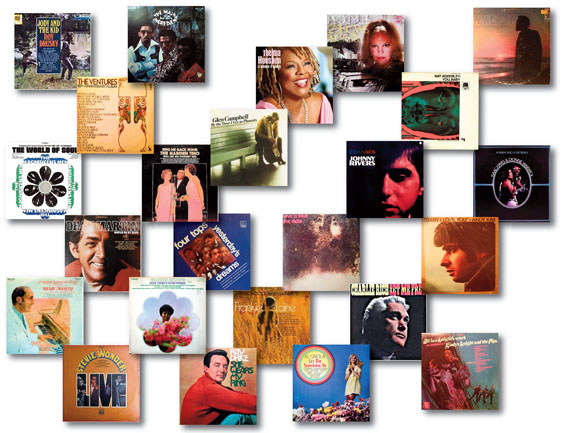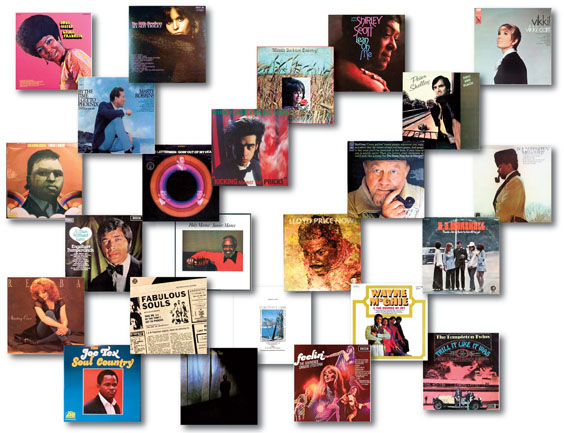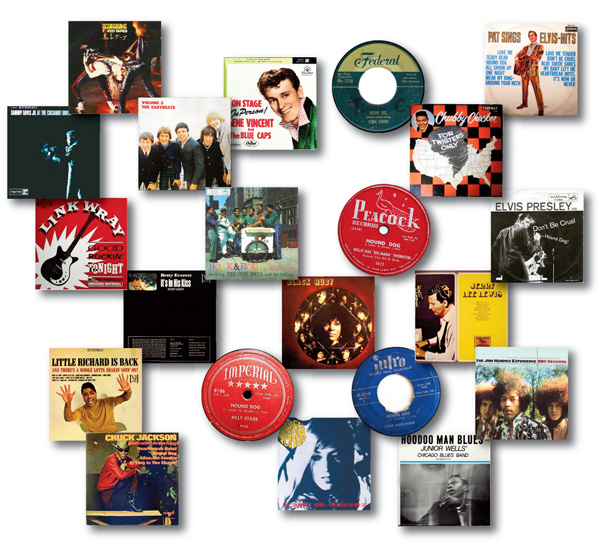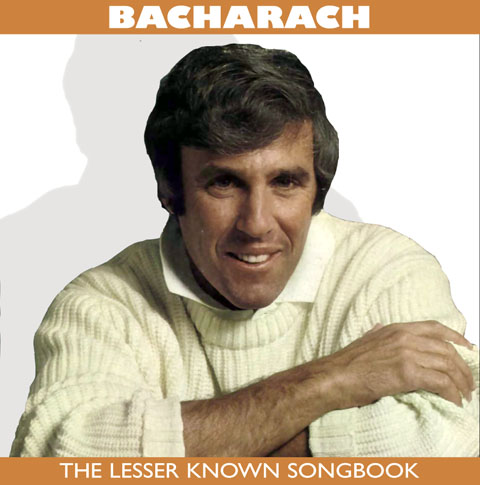Song Swarm: Girl From Ipanema
 Once upon a time, The Girl From Ipanema was the ultimate square song. You’d hear it piped in the elevator before you entered the lounge where the piano player would tinkle out the most laid back song in pop history to the point of banality.
Once upon a time, The Girl From Ipanema was the ultimate square song. You’d hear it piped in the elevator before you entered the lounge where the piano player would tinkle out the most laid back song in pop history to the point of banality.
Today, the song is cool again. At the opening ceremony of the Rio Olympics, supermodel Gisele Bundchen came out strutting out to it. And this song swarm shows a fairly high number of recent covers for a song that resides recognisably in the 1960s. The Girl From Ipanema is cool again.
Bundchen got to play the girl from Ipanema, but the actual woman who inspired the song was not invited to the opening ceremony. And it’s not like Helô Pinheiro fell into obscurity after the poet Vinícius de Moraes immortalised her in the song.
Songwriters Antônio Carlos “Tom” Jobim and lyricist Vinicius de Moraes were sitting in the Veloso bar in the Ipanema beachfront district of Rio one winter’s day in 1962 when they noticed a pretty school girl — Helô Pinheiro — walking past them in her jacket-and-tie school uniform, and later in her bikini on the way to the beach. And day by day, they’d see her again, passing by and being observed by the two middle-aged men. And sometimes the 15-year-old would come into the bar to buy cigarettes for her mother.

Helô Pinheiro, the inspiration for The Girl Fom Ipanema, on the beach.
Folklore has it that the men wrote this new, yet untitled song right there in the bar. In truth, they wrote it separately, Jobim working out the melody meticulously on his piano; de Moraes investing his poetic energy in creating that bitter-sweet erotic yearning of man for the unattainable — a melancholy underscored by the rising minor key changes in the “Oh, but he watches so sadly” set of lines. And so the song that started life as “Girl Passing By” emerged as Gârota de Ipanema — The Girl From Ipanema..
The newly-hatched song was first performed at Rio’s Bon Gourmet restaurant, with the singer João Gilberto on vocals. Gilberto also recorded an unreleased version before it was cut on record by a vocal group called Os Cariocas (which means The Rio de Janeireans) and then by bossa nova singer Pery Ribeiro and the otherwise quite forgotten Tamba Trio. These four early versions are feature here. They are not bad, but it would take a stroke of genius to create the template from which almost every other version would flow.
In 1963 the jazz saxophonist Stan Getz had become obsessed with that new bossa nova sound from Brazil, and invited its pioneers, Tom Jobim and João Gilberto, to New York for an album of collaborations. Lyricist Norman Gimbel — the only famous songwriter to have corresponded with this blog — was called in to write English lyrics for the lilting tune about the girl from… oh, he was going to change that unpronounceable name. As Jobim remembered it years later in conversation with the music journalist James Woodall — and Gimbel might have different recall — it took a taxi ride in bitterly cold New York to persuade the American lyricist that firstly, a word such as Ipanema existed, and secondly to leave the name of the beach in the lyrics, for “maybe one day everyone will know about it”.
 And so Gilberto, Jobim and Getz found themselves in the studio with Gimbel’s reworked lyrics. The problem was that Gilberto’s English wasn’t really up for the new version. So his wife Astrud was roped in — not quite as much by chance as myth would have it, and she certainly wasn’t the novice of legend. Although not yet a professional singer, Astrud had sung with João before, and she was in the studio with a view of singing something. That this something was The Girl From Ipanema was the stroke of genius. Astrud’s cool voice gave the song an innocent sexuality, as if she was the girl from Ipanema singing about herself in the third person. And even as she made the song more sexual, by dint of being a sung by a woman the lyrics lost the innate creepiness of a middle-aged man lusting after a teenage girl.
And so Gilberto, Jobim and Getz found themselves in the studio with Gimbel’s reworked lyrics. The problem was that Gilberto’s English wasn’t really up for the new version. So his wife Astrud was roped in — not quite as much by chance as myth would have it, and she certainly wasn’t the novice of legend. Although not yet a professional singer, Astrud had sung with João before, and she was in the studio with a view of singing something. That this something was The Girl From Ipanema was the stroke of genius. Astrud’s cool voice gave the song an innocent sexuality, as if she was the girl from Ipanema singing about herself in the third person. And even as she made the song more sexual, by dint of being a sung by a woman the lyrics lost the innate creepiness of a middle-aged man lusting after a teenage girl.
The Girl From Ipanema was a big hit. Released on the Verve label, it peaked at #5 on the Billboard charts and won a Grammy. And it became an instant standard. Even Mrs Miller did a butchered version (it is here, if you dare to listen). Frank Sinatra recorded it with João Gilberto to great effect, as did fellow crooner Sammy Davis Jr, helped by Count Basie. And Lou Rawls’ take might be the best of the lot. Whereas Henry Mancini turned it into revoltingly cheesy easy listening. In Brazil the Astrud Gilberto template apparently didn’t hold: the 1965 version of by the flamboyant bossa nova singer Cauby Peixoto, who died in May this year, pays no mind to what came before.
What became of the protagonists in this story? Astrud had a moderately successful singing career, though she never shook off the Ipanema girl burden. She unofficially retired in 2002. Aged 76, she is still alive. Stan Getz, whose affair with Astrud put an end to his working relationship with João for the next 12 years, died in 1991. Jobim went three years later, shortly after finishing his final album, Antonio Brasileiro. He died a national treasure, having also written such Brazilian classics as Desafinado and One Note Samba. João Gilberto, who like Gimbel is still alive, is still recording. Vinícius de Moraes died in 1980 at the age of 66.
And the Girl from Ipanema, Helô Pinheiro, who wasn’t invited to the opening ceremony of the Olympics where the famous song about her was highlighted as a legacy of Brazilian culture? She had stints as an actress and as a model, posing twice nude in Playboy (in 1987 and again 2003, with her daughter!).
In 2001 the heirs of the composers sued Pinheiro for naming her boutique Garota de Ipanema, arguing that her inspiration of the song was just incidental and she therefore had no right to use the song title for her store. Pinheiro, who received widespread public support, won the court case, having cited a press release by Jobim (who had been the best man at her wedding) and de Moraes in which the composers named her the original “Girl from Ipanema”. And so here are 69 versions of The Girl From Ipanema/Gârota de Ipanema. To unpack the lot you will need both files.
And so here are 69 versions of The Girl From Ipanema/Gârota de Ipanema. To unpack the lot you will need both files.
1962: João Gilberto Gilberto • Os Cariocas 1963: Pery Ribeiro • Tamba Trio • Getz/Gilberto • Antônio Carlos Jobim • Anita O’Day 1964: Henri Mancini • Andy Williams & Antonio Carlos Jobim • Oscar Peterson Trio • Peggy Lee • Stan Getz Quartet feat. Astrud Gilberto (Newport Jazz Festival) • Jacqueline François (as La Fille D’ipanema) • Little Anthony & The Imperials • Sarah Vaughan • Julie London • Sacha Distel & Dionne Warwick • Vince Guaraldi & Bona Sete • Nancy Wilson • Herb Alpert’s Tijuana Brass 1965: Cauby Peixoto • Nat King Cole • Sammy Davis & Count Basie • Charlie Byrd • Petula Clark • Esther Phillips 1966: Walter Wanderley • Lou Rawls • Shearing Quintet • Cher • Supremes • Chad & Jeremy • Freddie McCoy • Chris Montez • Mrs. Elva Miller 1967: Baden Powell • Sinatra & Antonio Carlos Jobim 1968: Erroll Garner • Lena Horne 1969: Denny McLain 1970: Roger Williams 1971: Nara Leão 1972: Percy Faith and his Orchestra 1974: Toots Thielemans 1975: Eartha Kitt • John Holt – Girl From Ipanema 1976: Gilla (as Machen wir’s in Liebe) • Giovanni Fenati (as La Ragazza di Ipanema) 1977: Astrud Gilberto (Disco Version) 1981: Ella Fitzgerald 1983: Vinicius e Toquinho 1990: Nigel Kennedy 1996: Teddy Edwards & Houston Person • Crystal Waters 1997: Al Jarreau & Oleta Adams • Salena Jones 1998: Gabriela Anders 2000: Rosemary Clooney feat. Diana Krall 2001: Walter Bell 2003: Lisa Ono 2005: Dan Gibson’s Solitudes 2008: Eliane Elias 2011: Placido Domingo • Amy Winehouse • Pat Metheny 2013: Andrea Bocelli
Previous Song Swarms:
By The Time I Get To Phoenix
Hound Dog
Sunny
These Boots Are Made For Walking
Sunday Morning Coming Down
Like A Rolling Stone
Papa Was A Rolling Stone
Rudolph The Red-Nosed Reindeer
Over The Rainbow
Georgia On My Mind
Blue Moon
Light My Fire





























Recent Comments